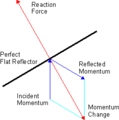Radiation pressure facts for kids
Radiation pressure is a tiny push that light and other forms of electromagnetic radiation (like radio waves or X-rays) put on any surface they hit. Think of it like a very gentle breeze, but made of light! This push happens because light waves carry a tiny bit of momentum with them. When these waves hit a surface, they transfer that momentum, causing a small force or pressure.
This pressure is usually very, very small, so we don't feel it in our daily lives. However, it's important in space and for very sensitive scientific experiments.
What is Radiation Pressure?
Radiation pressure is the force that light or other types of radiation put on a surface. Imagine light as tiny packets of energy called photons. When these photons hit something, they give it a little nudge. This nudge creates pressure.
If a surface absorbs the light, it gets a certain amount of push. But if the surface reflects the light, the push is actually twice as strong! This is because the photons not only stop, but they also bounce back, giving an extra push.
How Strong is This Push?
Even though radiation pressure is small, it's real. For example, the Sun constantly sends out light and energy. When this sunlight reaches Earth, it creates a tiny radiation pressure. The energy from the Sun hitting one square meter of Earth's surface is about 1370 watts. This creates a pressure of about 4.6 micropascals (µPa) if the light is absorbed. A micropascal is a very, very small unit of pressure.
While this pressure is too small to feel on Earth, it can be important over long distances or with very powerful light sources. Scientists are even looking at using radiation pressure to power solar sails for spacecraft! These sails would use the Sun's light to push spacecraft through space without needing rocket fuel.
Images for kids
See also
 In Spanish: Presión de radiación para niños
In Spanish: Presión de radiación para niños



